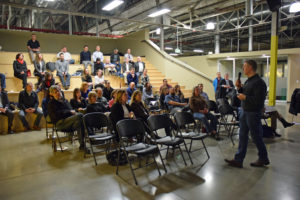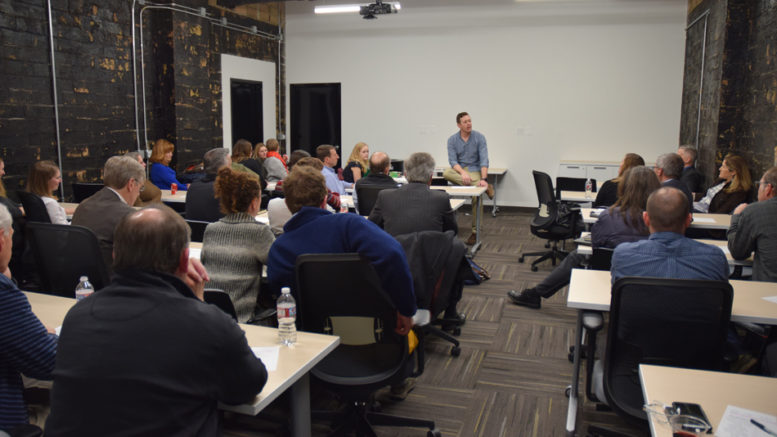DENVER, Colo. – Tom Higley has created a new feature of the innovation economy. It’s not an incubator. It’s not an accelerator. It’s a venture generator. And if it works, it’s going to generate a huge number of health-tech startups.
“Accelerators like Y Combinator and TechStars are focused on what happens after you’ve started a company,” Higley explained last Monday. “Maybe it’s time to turn our focus to what happens before a new venture is created.”
He was standing in the auditorium of a co-working space in downtown Denver, speaking to an audience of dozens of entrepreneurs, technologists, and clinicians, and sharing his thoughts on the process of venture generation. It was his clearest articulation yet of an idea that has already produced several health-tech startups, including BurstIQ, Airstream Health, and Concert Health.
“What entrepreneurs care about is identifying a problem that matters to them and to the world,” Higley explained. “The entrepreneur’s first job is to make sure they’ve identified a worthwhile opportunity. But that’s not enough. They then have to turn that opportunity into reality. That’s what we focus on at 10.10.10.”

Tom Higley, 10.10.10’s founder, discusses the process of venture generation at 10.10.10 Health’s February meet-up.
The audience had gathered for 10.10.10 Health, a monthly meet-up that culminates each year in a 10-day-long, healthcare-focused venture generation program. (Read the CyberMed News profile of 10.10.10 Health here.) 10.10.10 Health’s first program occurred in 2015, and led to the formation of two health-tech startups. Its second program took place in 2016, and may well produce several more.
“10.10.10 connects two parts of the world that don’t ordinarily come into contact,” Higley continued. “We try to do that in a way that’s safe and positive and beneficial to those who live on both sides. On one side are the entrepreneurs. On the other are the established organizations and institutions.”
A successful entrepreneur, an experienced investor, and a longtime mentor, Higley has designed 10.10.10 Health to provide entrepreneurs with all of the resources they need to form successful companies. Perhaps the most conspicuous feature of the program is the community it creates, which generally consists of more than a hundred volunteers. According to Higley, this community often serves as a support network for the participants of 10.10.10 Health long after the program ends.
“On one side, you’re living in a world of speedy decisions, focus, small, rapid tests, customer development, failure tolerance, pivot and retest, and minimum viable product. This is the entrepreneur’s vocabulary,” Higley explained. “On the other side, there’s an established business model. You’re not trying to figure it out; you’re just trying to make it better.”
Each year, 10.10.10 Health brings these worlds together, with the entrepreneurs in the program coming into daily contact with the clinicians, executives, and investors who serve as its volunteers. But 10.10.10 Health is only now entering its third year, and its system of venture generation is still being defined. What made February’s gathering so interesting was Higley’s newfound understanding of the processes at work within the program.
“We start by listening,” he told the audience. “We’re trying to understand from knowledgeable people, organizations, and institutions. We’re trying to find out what problems have not been addressed, and which of those problems can be addressed by entrepreneurs.”
According to Higley, the listening phase is followed by a learning phase, in which entrepreneurs work with volunteers to explore the problems they encounter during the program. Participants then immerse themselves in a problem of their choosing, studying its history, researching its context, and considering possible solutions.
Once they’ve gained a working sense of the problem, they enter the next phase of the program, leverage. In this phase, the entrepreneurs and volunteers search for what Higley calls an “unfair advantage.” This often consists of new technology, intellectual property, or policy changes that give the entrepreneurs the ability to do something their competitors cannot.
In the final phase, the entrepreneurs launch their companies. “When a startup is created through a process like this, you have some powerful advantages,” Higley explained. “What you end up with is incredible leverage as you’re starting a new venture.”
With preparations for 10.10.10 Health 2017 in full swing, Higley will soon have the chance to test his new model of venture generation. Among the members of 10.10.10, hopes are high that a refined understanding of the processes involved in the program will lead to improved rates of company formation. With the goal of 10.10.10 Health to create market-based solutions to problems like toxic stress, childhood obesity, and Alzheimer’s disease, the impact of a more efficient program has the potential to be widely felt.
“The government probably isn’t going to address these problems. Large industries are probably not going to address these problems. Research institutions are probably not going to bring to market the solutions to these problems,” Higley admitted. “Who’s going to address them? We believe it’s successful serial entrepreneurs working in a process like this who can and will.”
Like the coverage that CyberMed News provides? Follow us on Twitter, LinkedIn, and Facebook to keep up-to-date on the latest developments in digital health.






Be the first to comment on "Generating the Future of Healthcare at 10.10.10 Health 2017"